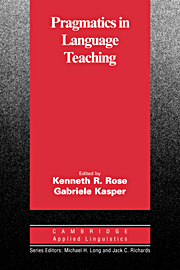Book contents
- Frontmatter
- Contents
- List of contributors
- Series editors' preface
- Preface
- Chapter 1 Pragmatics in language teaching
- I THEORETICAL AND EMPIRICAL BACKGROUND
- Chapter 2 Evaluating the empirical evidence: Grounds for instruction in pragmatics?
- Chapter 3 Classroom research on interlanguage pragmatics
- II ISSUES IN CLASSROOM-BASED LEARNING OF PRAGMATICS
- III THE EFFECTS OF INSTRUCTION IN PRAGMATICS
- IV THE ASSESSMENT OF PRAGMATIC ABILITY
- References
- Name index
- Subject index
Chapter 3 - Classroom research on interlanguage pragmatics
Published online by Cambridge University Press: 05 October 2012
- Frontmatter
- Contents
- List of contributors
- Series editors' preface
- Preface
- Chapter 1 Pragmatics in language teaching
- I THEORETICAL AND EMPIRICAL BACKGROUND
- Chapter 2 Evaluating the empirical evidence: Grounds for instruction in pragmatics?
- Chapter 3 Classroom research on interlanguage pragmatics
- II ISSUES IN CLASSROOM-BASED LEARNING OF PRAGMATICS
- III THE EFFECTS OF INSTRUCTION IN PRAGMATICS
- IV THE ASSESSMENT OF PRAGMATIC ABILITY
- References
- Name index
- Subject index
Summary
Introduction
Pragmatics has played a considerable role in first and second language classroom research, but classroom research has played only a minor role in interlanguage pragmatics thus far. Virtually all of the instruments designed for L2 classroom observation include, or are even entirely based on, pragmatic and discourse categories, for instance, the FLint (Foreign Language Interaction) system (Moskowitz, 1971), the FOCUS (Foci for Observing Communications Used in Settings) system (Fanselow, 1977), the Embryonic Category System (Long, Adams, McLean, & Castaños, 1976), or the COLT (Communicative Orientation in Language Teaching) system (Fröhlich, Spada, & Allen, 1985) (see illustration and discussion of instruments and procedures for classroom research by Allwright, 1988; Chaudron, 1988; van Lier, 1988; Allwright & Bailey, 1991). As a case in point, an early observation schedule such as Moskowitz's FLint (1971) system included such speech-act categories for examining teacher talk as accepting, discussing, referring to, praising, complimenting, confirming, joking, clarifying, summarizing, repeating, asking questions, giving information, lecturing, correcting, giving directions, requesting, criticizing. Perhaps the most well known scheme for the analysis of classroom discourse is Sinclair and Coulthard's (1975), a hierarchically structured model based on Hallidayan systemic linguistics. Less well known in the English speaking world but much used in northern Europe is Ehlich and Rehbein's (1979) model, based on their pattern theory of action. Although the theoretical origin of Ehlich and Rehbein's model and its formal and functional properties differ considerably from Sinclair and Coulthard's, each represents a distinct discourse-pragmatic approach to classroom interaction.
- Type
- Chapter
- Information
- Pragmatics in Language Teaching , pp. 33 - 60Publisher: Cambridge University PressPrint publication year: 2001
- 72
- Cited by



